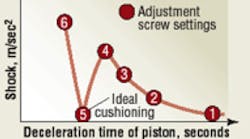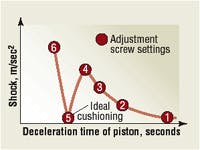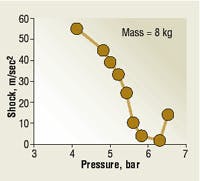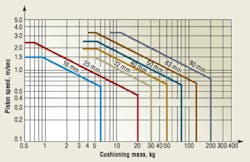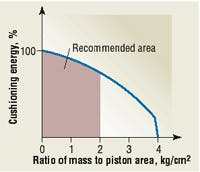Download this article in .PDF format
Cushioning of some sort normally is required to decelerate a cylinder's piston before it strikes the end cap. Reducing the piston velocity as it approaches the end cap lowers the stresses on cylinder components and reduces vibration transmitted to the machine structure.
End-of-stroke impact can be dealt with in three ways: by simple impact cushioning, pneumatic cushioning, or by installing shock absorbers. This discussion deals with pneumatic cushioning and is intended to serve as an instruction on how to optimize cushioning for a given mass.
The concept of ideal cushioning
Ideal pneumatic cushioning occurs when all kinetic energy is dissipated to decelerate the piston to exactly zero velocity when it reaches the end of its travel. Any contact between the piston and end cap would be negligible, so the piston would not rebound off the end cap. Ideal pneumatic cushioning produces minimal noise from end cover contact, and minimum piston deceleration time. Thus, properly adjusted pneumatic cushioning can improve the work environment and increase machine throughput in rapid-cycle applications.
Knowing operating pressure, cylinder characteristics, and the specified load mass, the first step is to ensure that the piston velocity is within that specified in cushioning charts in the manufacturer's catalog. The best results in adjusting piston velocity are obtained by installing throttling non-return valves directly in the cylinder end ports. This permits free inlet flow while allowing the outlet pressure to be adjusted simply by altering the area of the exhaust port with an adjusting screw. Directional-control valves with integral restrictors may be used as an alternative.
A critical aid in achieving ideal conditioning is an electronic instrument to measure piston velocity. Such an instrument also allows measuring the time for all sequences in a cylinder cycle.
Understanding the dynamics
Although the cushioning adjustment from the factory may prevent the piston from striking the end cap on its first stroke, the cushioning is far from ideal. Furthermore, the factory adjustment may also provide too much damping, making it difficult to achieve rapid cycling.
Figure 1 illustrates what can occur when the adjusting screw is opened, with all other parameters being constant. Starting at point 1, which represents the initial factory setting, opening the adjusting screw a turn at a time moves the setting to the left. During the first two to three adjustments, the deceleration time becomes progressively shorter, but the end impact becomes correspondingly higher. The normal reaction at this point is to stop, and return the adjusting screw toward the original setting to reduce the increasing shock.
However, ideal cushioning is achieved by continuing to open the screw an additional one to two turns. At some point, the end impact reaches its minimum, point 5 in Figure 1. Continuing to open the adjusting screw will cause end impact to suddenly increase substantially without a significant reduction in deceleration time. So at the ideal pneumatic cushioning point, not only is end shock minimized, but deceleration time is also reduced, which translates to shorter cycle times. A 20% to 40% reduction in total cycle time is not unusual when ideal cushioning is achieved.
Effects of pressure variations
So far, all parameters have been assumed to be constant, with changes made only to the cushioning setting. In reality, though, operating pressure often fluctuates, especially in large circuits having dozens of actuators and end effectors. The effects of pressure variations demonstrate the importance of providing consistent pressure control. This is best accomplished by specifying properly sized flow passages to minimize pressure drop and strategically placing pressure regulators where ever they are needed.
Operating pressure can have a dramatic effect on end-of-stroke shock, Figure 2. As shown, ideal pneumatic cushioning for a given mass occurs at 6.3 bar. But end impact shock increases sharply if pressure decreases. At 5 bar, the cylinder is subjected to a shock equivalent to 30 to 40 times the mass it was intended to cushion. Apart from loud noise, severe vibration, and a longer cycle time, this shortens the life of the cylinder appreciably. Unfortunately, higher pressure produces the same result.
Over and underdamping
Ideal cushioning cannot be achieved with an overdamped cylinder. This is because the effects of damping will become progressively worse, regardless of the adjustment. Any of three actions may be taken to solve this problem.
Increase piston velocity — Piston velocity can be raised by increasing the area of the cylinder outlet port, adjusting throttling non-return valves, or altering the restrictors in the outlet ports of directional control valves. Sufficient kinetic energy for ideal cushioning can be developed by this means.
Reduce operating pressure — This may be accomplished simply by installing a pressure regulator in the feed line to the cylinder.
Increase the moving mass — A higher kinetic energy can be achieved by increasing the moving mass, although, in practice, this can be difficult to achieve.
If severe shock occurs regardless of the cushioning adjustment setting, the cylinder is underdamped. In this case, the possible courses of action are the opposite of those described for overdamped conditions. To correct underdamping:
• reduce the piston velocity,
• increase operating pressure,
• reduce the mass, or
• incorporate external shock absorbers into the cylinder assembly.
How to achieve ideal cushioning
Most people determine cylinder bore based primarily on the thrust required, with no regard for kinetic energy. Usually, this produces a cylinder cushioning capacity that well exceeds that necessary for the application. This will suffice if ideal pneumatic cushioning is not required. But if it is required, pneumatic cushioning will be unachievable with certain combinations of bore, load, and operating pressure.
If the cushioning energy required is within 10% of the cylinder's initial setting, the adjusting screw can be opened to allow the piston to strike the end cover. The shock will be moderate due to the low load, the impact time will be short, and the braking effect of the cushioning will be low because of the short time available for backpressure to develop.
However, if the required cushioning energy exceeds 10% of the initial setting, but is less than 80%, a different scenario applies. If required cushioning is 10% to 80% below the initial setting, the piston can be cushioned partially with air, with impact cushioning accounting for the remainder of the energy absorption. Some impact shock will occur, and the adjusting screw will be almost completely open.
If required cushioning is 10% to 80% higher than the initial setting, the adjusting screw will have to be closed almost completely. The kinetic energy will be damped, and the piston will travel toward the end cover at a certain velocity. However, the shock will be less than in the case described above. The condition is referred to as rebound cushioning. With rebound cushioning, the piston changes direction two or three times as deceleration progresses, which makes the total cycle time somewhat longer.
A better approach
To this point, scenarios have dealt with cases in which the cylinder was already selected, so the pneumatic cushioning had to be adjusted. Achieving ideal pneumatic cushioning is much less complicated if certain factors are taken into account when specifying the cylinders.
First, cylinders should be specified according to cushioning charts contained in manufacturers' catalogs. A typical example is shown in Figure 3.
For this discussion, we will assume a horizontal installation, with a minimum stroke of 200 mm, and an operating pressure of 6.3 bar. A good rule of thumb for choosing the correct cylinder is that the ratio of the load mass (in kg) to the piston area (in cm2) should not exceed four. This limit is represented by the vertical line for each bore size shown in Figure 3. Ideal cushioning can be achieved, without changing the operating pressure, if the intersection of mass and velocity-is on or just below the inclined line in the chart.
Effect of mounting orientation
The horizontal cushioning charts also can be used when the piston operates vertically downward. If the cylinder is installed with piston traveling upward, the cushioning capacity will be less, due to the reduction in cushioning pressure. The force of gravity, which acts downward, reduces the cushioning capacity. Figure 4 serves as a guide, as does this rule of thumb:
m/A < 2
where m = mass, kg and
A = piston area, cm2
Figure 5 shows that full cushioning capacity is achieved only when our specified cylinder has a stroke of at least 200 mm. Note that the cushioning energy decreases sharply when stroke is less than the recommended minimum.
Again, the operating pressure, mass, and velocity govern the characteristics of cushioning. Once ideal cushioning has been achieved, the application parameters must remain unchanged — otherwise, any variation would require cushioning energy to be readjusted.
Phil O'Neill is Industrial Products Manager at Bosch Rexroth Corp., Pneumatics Div., Lexington, Ky. Bosch Rexroth Pneumatics is now Aventics; click here for more information.
Click here to download a 12-page PDF detailing cylinder cushioning.
Click here to watch a video demonstrating ideal cushioning.
